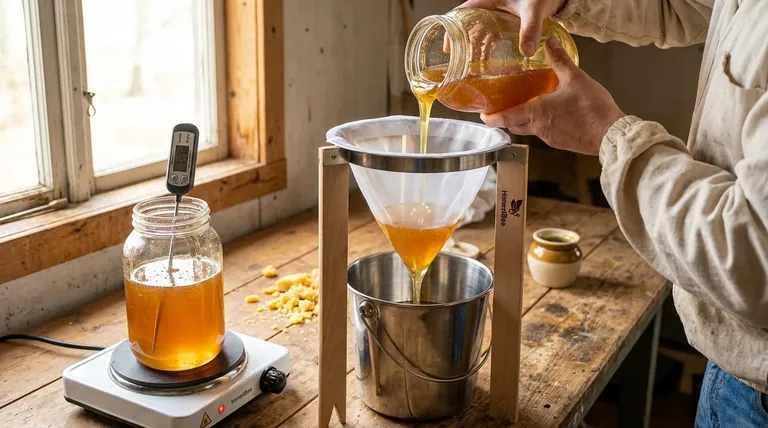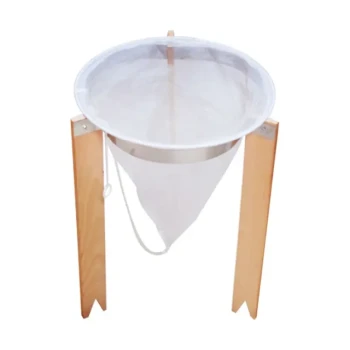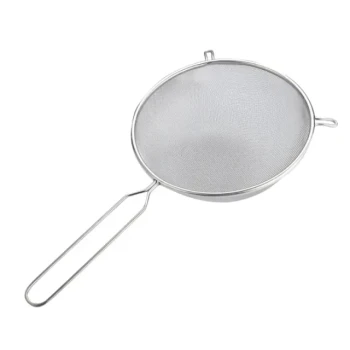To filter raw honey, the most common method is to gently warm the honey to approximately 100°F (38°C) and pour it through a fine-mesh nylon strainer bag fitted inside a food-grade bucket. This process removes large debris like beeswax and propolis while being gentle enough to preserve the honey's natural enzymes and character.
The core challenge of filtering raw honey is removing unwanted physical impurities without stripping away the beneficial compounds that define it. Your chosen method will always be a trade-off between clarity, speed, and the preservation of the honey's natural state.

The Goal: Clean Honey, Preserved Quality
Before choosing a method, it's critical to understand what you are trying to remove and, more importantly, what you are trying to keep.
What You're Removing
Filtering primarily targets physical debris left over from the extraction process.
This includes unwanted materials such as bits of beeswax, fragments of propolis, and other hive debris like wood splinters or insect parts. Removing these creates a cleaner, more appealing final product.
What You Want to Keep
The term "raw" implies the honey has not been pasteurized (heated to high temperatures). This preserves its natural profile.
You want to retain the beneficial enzymes and microscopic pollen grains, which are hallmarks of raw, unprocessed honey and are valued by many consumers.
Primary Filtering Methods
There are two main approaches for a small-scale beekeeper, each with its own advantages.
Method 1: Gravity Straining
This is the most active and common method for home beekeepers.
You will need a food-grade five-gallon bucket and a fine-mesh nylon strainer bag designed for honey. Simply fit the bag inside the bucket, pour in your honey, and allow gravity to pull it through the mesh.
Once the honey has passed through, you slowly lift the bag out of the bucket, allowing the remaining honey to drain while the debris stays behind.
The Role of Gentle Heat
Honey is viscous and flows very slowly, especially at cooler temperatures. Gently warming it to around 100°F (38°C) dramatically speeds up the straining process from hours to minutes.
This low temperature is just enough to improve flow without "cooking" the honey or destroying its beneficial enzymes.
Method 2: Settling and Decanting
This is a passive, no-heat method that relies on time and gravity.
Pour your unfiltered honey into a bottling container or large jar and let it sit undisturbed for one to two weeks. During this time, lighter particles like beeswax will rise to the top, and heavier debris will sink to the bottom.
You can then carefully bottle the clean honey from the middle layer, leaving the impurities behind.
Understanding the Trade-offs
Choosing a method requires balancing your goals for the final product with the resources you have available.
Speed vs. Preservation
Gentle heating and straining is fast and efficient. However, it requires careful temperature control to avoid damaging the honey.
The settling method is the most gentle and requires no special equipment, but it is extremely slow and demands patience.
Clarity vs. "Raw" Character
Using a very fine mesh strainer will produce exceptionally clear honey, which can be visually appealing to customers.
However, extremely fine filters can also remove more of the fine pollen particles, which some consumers specifically seek out in raw honey. The goal is to strain, not to micro-filter.
Specialized Equipment
For larger operations, dedicated honey filtering machines exist. These can streamline the process but represent a significant investment and are generally unnecessary for hobbyists.
Making the Right Choice for Your Goal
Your ideal method depends entirely on your priorities for time, effort, and the final product.
- If your primary focus is speed and efficiency: Use the gravity straining method with honey gently warmed to around 100°F (38°C).
- If your primary focus is preserving the honey in its most unaltered state: Use the settling and decanting method, but be prepared to wait.
- If your primary focus is a very clear product for sale: Use a fine-mesh nylon strainer, likely combined with gentle heat to make it flow effectively.
Ultimately, the best filtering method is the one that produces honey you are proud of, balancing purity with its natural, raw character.
Summary Table:
| Method | Process | Best For | Key Consideration |
|---|---|---|---|
| Gravity Straining | Warm honey to ~100°F (38°C) and pour through a nylon strainer bag. | Speed and efficiency. | Requires careful temperature control to avoid damaging honey. |
| Settling & Decanting | Let honey sit for 1-2 weeks; bottle the clean middle layer. | Maximum preservation of raw character. | Very slow process; requires patience. |
Ready to scale your honey production with professional-grade equipment?
As a beekeeper, you know that quality equipment is key to efficiency and product integrity. HONESTBEE supplies commercial apiaries and beekeeping equipment distributors with the durable, high-capacity supplies needed for operations of any size.
We can help you streamline your process with reliable filtering systems, food-grade buckets, and more. Let's discuss how our wholesale-focused solutions can support your business growth.
Contact HONESTBEE today for a consultation tailored to your commercial beekeeping needs!
Visual Guide

Related Products
- Professional Honey Filter with Tripod Support Stand
- Professional Cone-Shaped Honey Filter with Reinforced Steel Ring
- Two-Stage Plastic Honey Filter for Buckets
- Nylon Honey Strainer Square Filter Cloth for Honey Filters
- Professional Stainless Steel Honey Filter with Support Handle
People Also Ask
- Is it necessary to filter honey after extraction? A Guide to Straining vs. Raw Honey
- What filter size for honey? A Beekeeper's Guide to Straining for Clarity and Quality
- Why is filtering honey an important step in honey processing? Ensure Purity, Clarity & Marketability
- What is the simple straining method for honey processing? A Guide to Raw Honey for Hobbyists
- What is the role of filtration in honey processing? Ensure Purity, Clarity, and Shelf Life



















